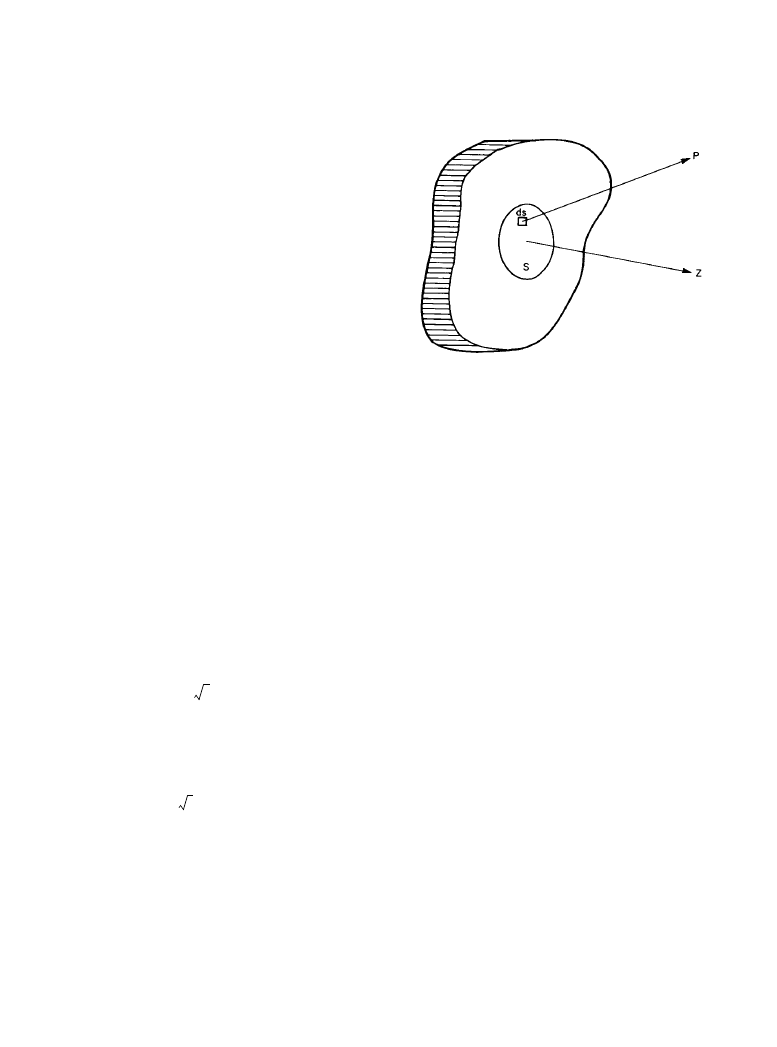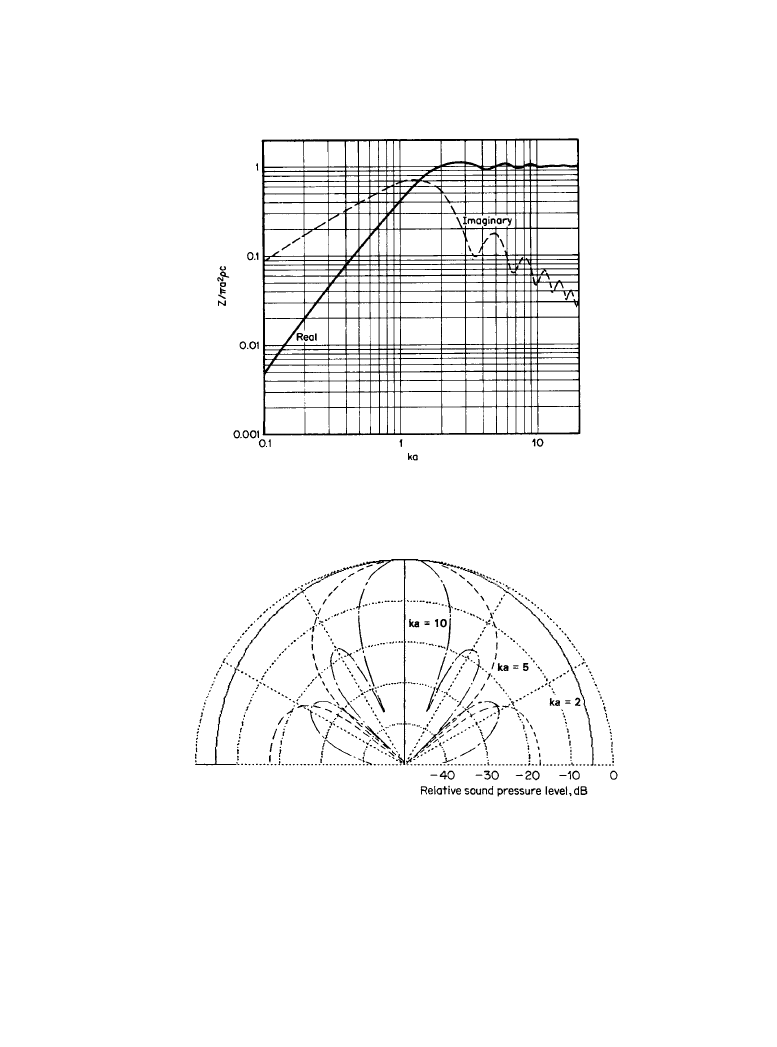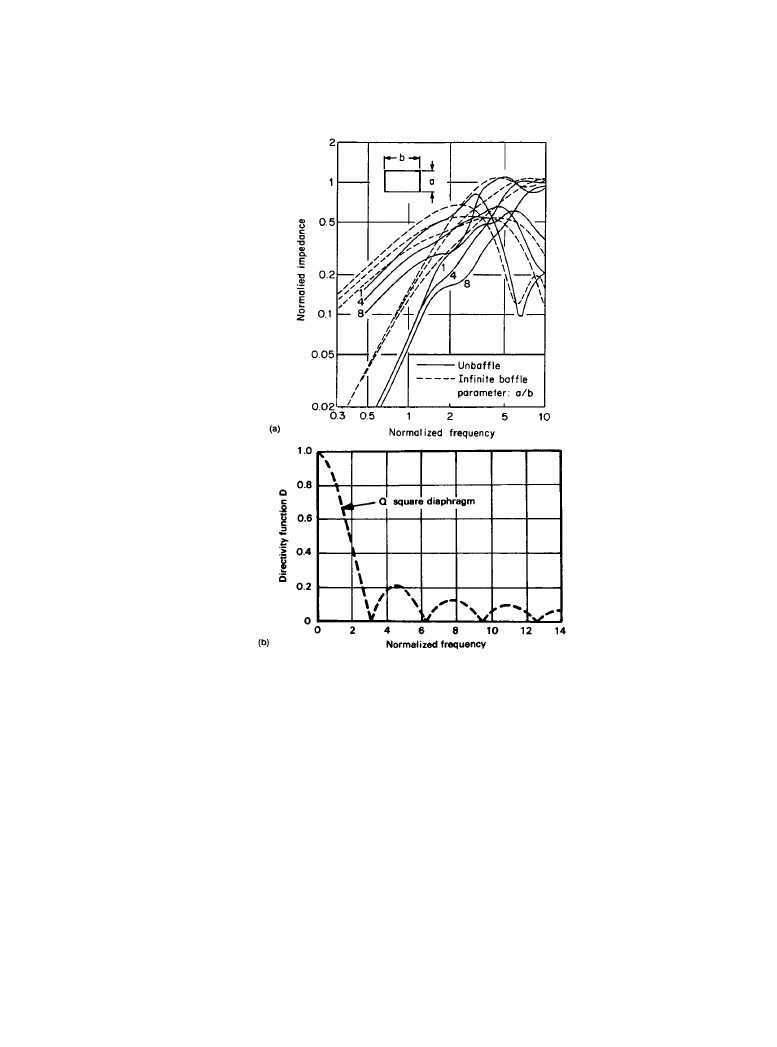ВУЗ: Казахская Национальная Академия Искусств им. Т. Жургенова
Категория: Книга
Дисциплина: Не указана
Добавлен: 03.02.2019
Просмотров: 21667
Скачиваний: 19

5-17
Chapter
5.2
Direct-Radiator Loudspeakers
Katsuaki Satoh
5.2.1
Introduction
The diameter of a speaker diaphragm normally ranges between a few centimeters and dozens of
centimeters when high-amplitude sound must be produced. The following sections outline the
basic principles involved in direct-radiator loudspeakers.
5.2.2
Piston Source in an Infinite-Plane Baffle
An actual diaphragm has many different oscillation modes, and its motion is complicated. On the
assumption—for easier analysis—that the diaphragm is rigid, radiation impedance and directiv-
ity are considered for typical circular and rectangular shapes. As shown in Figure 5.2.1, part of a
circular rigid wall is oscillating at a given velocity v exp (j
ωt). The upper part of this circular pis-
ton is subdivided into the micro area d
s
, and when a micro part is oscillated by the piston, the
total reaction force subjected from the medium side is calculated. Thus, the radiation impedance
Z
R
of the diaphragm is found from the ratio of this reaction force to the diaphragm’s oscillating
speed. This shows how effectively sound energy from the diaphragm is used. Radiation imped-
ance in the circular diaphragm is shown in the following equation, and the results in Figure 5.2.2.
(5.2.1)
Where:
J
1
= Bessel function of the first order
S
1
= Struve function
Directional characteristics of the circular diaphragm are shown in the following equation, and
the results in Figure 5.2.3.
(5.2.2)
Z
R
πa
2
pC
(
) 1
J
1
2ka
(
)
ka
-------------------
–
j
S
1
2ka
(
)
ka
--------------------
+
=
D
θ
( )
2J
1
ka sin
θ
(
)
ka sin
θ
---------------------------------
=
Downloaded from Digital Engineering Library @ McGraw-Hill (www.digitalengineeringlibrary.com)
Copyright © 2004 The McGraw-Hill Companies. All rights reserved.
Any use is subject to the Terms of Use as given at the website.
Source: Standard Handbook of Audio and Radio Engineering

5-18 Sound Reproduction Devices and Systems
Where:
D(
θ) = ratio between sound pressures whose angles θ are in 0 and θ directions
θ = perpendicular on the surface center
k = number of waves
a = radius, m
Rectangular impedance is shown in Equation (5.2.3), directional characteristics in Equation
(5.2.4), and the respective calculation results in Figure 5.2.4.
(5.2.3)
Where:
v = nondimensional frequency
p =
R v,
σ
(
)
1
2/
πv
2
(
) 1 cos vq
( ) vq sin (vq ) cos vp
( ) cos v/p
(
)
–
–
+
+
[
]
–
=
2/
π
(
) pI
1
v,
σ
(
)
[
] I
1
v,1/
σ
(
)/p
+
+
X v,
σ
(
)
2/
πv
2
(
) sin vq
( ) vq cos vq
( ) v p 1/p
+
(
) sin vp
( ) sin v/p
(
)
–
–
+
–
[
]
=
2/
π
(
) pI
2
v,
σ
(
) I
2
v,1/v
(
)/p
+
[
]
–
v
k S
=
q
σ 1/σ
+
(
)
=
σ
Figure 5.2.1
Piston on an infinite rigid wall.
Downloaded from Digital Engineering Library @ McGraw-Hill (www.digitalengineeringlibrary.com)
Copyright © 2004 The McGraw-Hill Companies. All rights reserved.
Any use is subject to the Terms of Use as given at the website.
Direct-Radiator Loudspeakers

Direct-Radiator Loudspeakers 5-19
Figure 5.2.3
Directional characteristics of a circular diaphragm.
Figure 5.2.2
Radiation impedance for a rigid circular diaphragm in an infinite baffle as a function
of
k a = 2
π
a/
λ
.
Downloaded from Digital Engineering Library @ McGraw-Hill (www.digitalengineeringlibrary.com)
Copyright © 2004 The McGraw-Hill Companies. All rights reserved.
Any use is subject to the Terms of Use as given at the website.
Direct-Radiator Loudspeakers

5-20 Sound Reproduction Devices and Systems
(5.2.4)
Where:
D(
θ
1
,
θ
2
) = ratio between sound pressures in 0 and
θ
1
/
θ
2
directions (
θ
1
=
θ
2
= 0 is a perpendicu-
lar of the center on the rectangular surface)
λ = wavelength, m
d
1,2
= length of each side of rectangle, m
Radiation impedance shows how effectively sound energy is radiated, while directional gain is
used to show how expanding sound energy is radiated in space. The ratio of total acoustic energy
W is found by integrating the sound strength from that on a spherical surface a distance r from
the sound source with the sound strength that exists on the same point from the nondirectional
sound source that emits the same energy. This is expressed in decibels:
(5.2.5)
(5.2.6)
Where:
W = total acoustic energy, W
r = distance in the maximum sound pressure direction for standardization, m
P
max
= sound pressure at distance r, N/m
2
DI = directivity index (directional gain), dB
5.2.2a
Baffle Shape and Acoustic Characteristics
In the preceding section an infinite baffle was discussed, but such a baffle cannot be put to prac-
tical use. Conse
quently, it is necessary to precheck the types of characteristics that can be
obtained when a definite baffle is installed in a speaker. Because the sounds radiated to the front
baffle and reflected to the rear are opposite in phase, the difference in distance between the
I
1,2
1
1/
ξ t
2
–
(
)
1
2
⁄
cos
sin
vt
( )
ζ 1 2
⁄
–
(
)
ξ 1/ξ
+
(
) 1 2
⁄
(
)
∫
=
1,2, subscripts of I,
cos for 1 and sin for 2
=
D
θ
1
θ
2
(
)
sin
φ
1
φ
1
-------------
sin
φ
2
φ
2
------------
⋅
=
φ
1,2
πd
1,2
λ
-------------sin
φ
1,2
=
ξ
σor σ
–
=
W
r
2
pC
-------
P
·
r,
θ,φ
(
)
2
sin
2
θ
θ
d
( ) φ
d
(
0
π
∫
0
2
π
∫
=
DI
10 log
4
πr
2
W
-----------
P
·
max
2
pC
------------------
⋅
=
Downloaded from Digital Engineering Library @ McGraw-Hill (www.digitalengineeringlibrary.com)
Copyright © 2004 The McGraw-Hill Companies. All rights reserved.
Any use is subject to the Terms of Use as given at the website.
Direct-Radiator Loudspeakers

Direct-Radiator Loudspeakers 5-21
passes of sound through the rear and front baffles from a speaker is canceled by the front and rear
sounds of one-half even multiples and added to each other by the sounds of odd multiples.
Therefore, high and low sound pressures occur. To avoid this, the speaker is installed off cen-
ter, resulting in a baffle with a complicated shape. One side should be a few times longer than the
wavelength. However, this shape does not produce favorable characteristics, and this type of baf-
fle is not often used in practical applications. Typical baffle characteristics are shown in Figures
5.2.5 and 5.2.6.
Figure 5.2.4
Diaphragm characteristics: (
a) radiation impedance for a rigid rectangular dia-
phragm, (
b) directivity function for a rigid square diaphragm. Note that in (a) solid lines, which have
been calculated by using the finite element method (FEM), are instructive for practical designs.
Downloaded from Digital Engineering Library @ McGraw-Hill (www.digitalengineeringlibrary.com)
Copyright © 2004 The McGraw-Hill Companies. All rights reserved.
Any use is subject to the Terms of Use as given at the website.
Direct-Radiator Loudspeakers